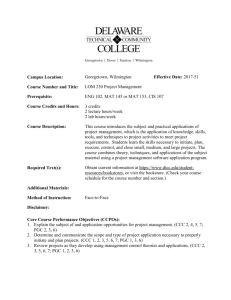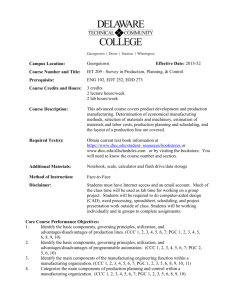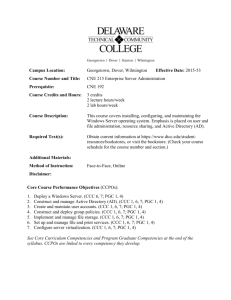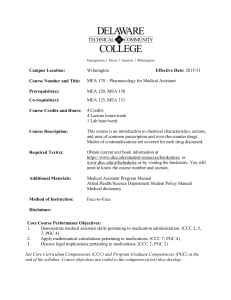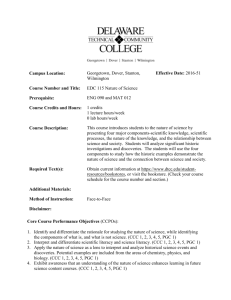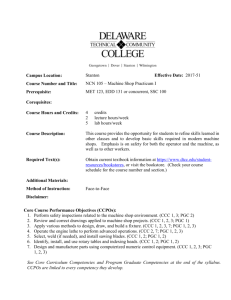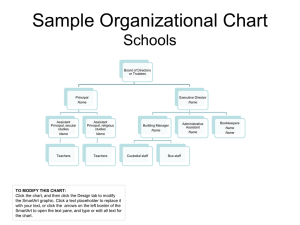Campus Location: Wilmington Effective Date: 2017
advertisement
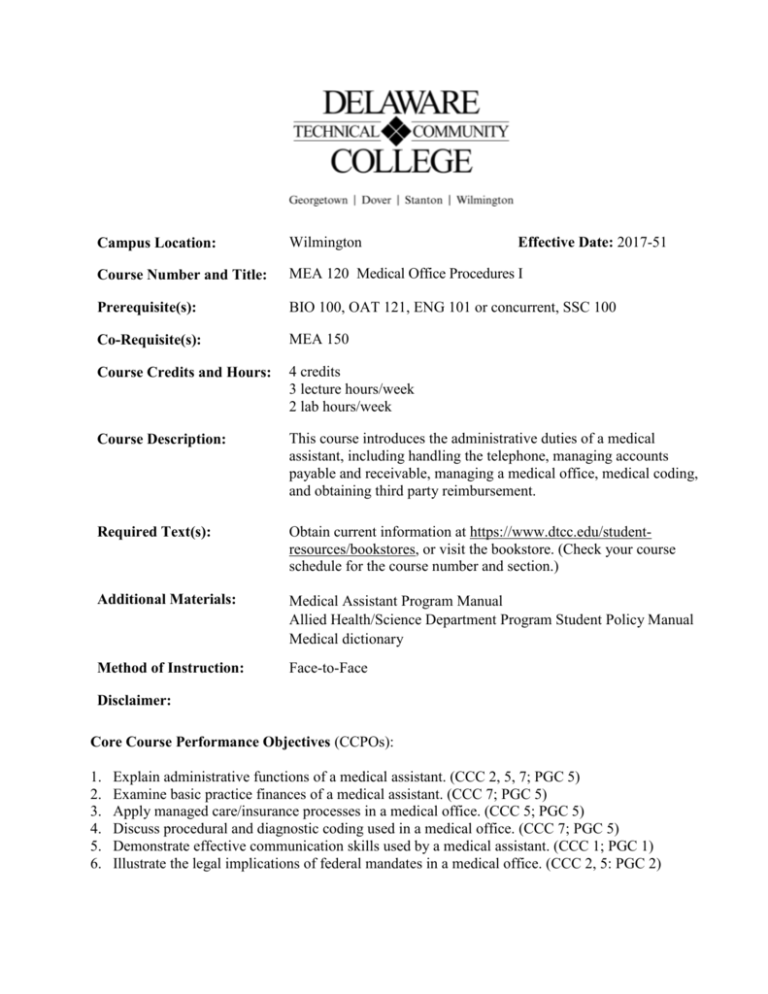
Campus Location: Wilmington Effective Date: 2017-51 Course Number and Title: MEA 120 Medical Office Procedures I Prerequisite(s): BIO 100, OAT 121, ENG 101 or concurrent, SSC 100 Co-Requisite(s): MEA 150 Course Credits and Hours: 4 credits 3 lecture hours/week 2 lab hours/week Course Description: This course introduces the administrative duties of a medical assistant, including handling the telephone, managing accounts payable and receivable, managing a medical office, medical coding, and obtaining third party reimbursement. Required Text(s): Obtain current information at https://www.dtcc.edu/studentresources/bookstores, or visit the bookstore. (Check your course schedule for the course number and section.) Additional Materials: Medical Assistant Program Manual Allied Health/Science Department Program Student Policy Manual Medical dictionary Method of Instruction: Face-to-Face Disclaimer: Core Course Performance Objectives (CCPOs): 1. 2. 3. 4. 5. 6. Explain administrative functions of a medical assistant. (CCC 2, 5, 7; PGC 5) Examine basic practice finances of a medical assistant. (CCC 7; PGC 5) Apply managed care/insurance processes in a medical office. (CCC 5; PGC 5) Discuss procedural and diagnostic coding used in a medical office. (CCC 7; PGC 5) Demonstrate effective communication skills used by a medical assistant. (CCC 1; PGC 1) Illustrate the legal implications of federal mandates in a medical office. (CCC 2, 5: PGC 2) See Core Curriculum Competencies and Program Graduate Competencies at the end of the syllabus. CCPOs are linked to every competency they develop. Measurable Performance Objectives (MPOs): Upon completion of this course, the student will: 1. Explain administrative functions of a medical assistant. 1.1 Identify different types of appointment scheduling methods. 1.2 Identify advantages and disadvantages of the manual and electronic appointment systems. 1.3 Identify critical information required for scheduling patient procedures. 1.4 Express sensitivity when managing appointments. 1.5 Define types of information contained in the patient’s medical record. 1.6 Identify methods of organizing the patient’s medical record based on problem-oriented medical record (POMR) and source-oriented medical record (SOMR). 1.7 Identify equipment and supplies needed for medical records in order to create, maintain, and store. 1.8 File patient medical records. 2. Examine basic practice finances of a medical assistant. 2.1 Define charges, payments, accounts receivable, accounts payable, and adjustments. 2.2 Describe banking procedures as related to the ambulatory care setting. 2.3 Identify precautions for accepting payments of cash, checks, credit cards, and debit cards. 2.4 Describe types of adjustments made to patient’s accounts, including non-sufficient funds (NSF) check, collection agency transaction, credit balance, and third party. 2.5 Identify types of information contained in the patient’s billing record. 2.6 Explain patient financial obligations for services rendered. 2.7 Perform accounts receivable procedures to patient accounts, including posting charges, payments, and adjustments. 2.8 Prepare a bank deposit. 2.9 Collect accurate patient billing information. 2.10 Discuss how to inform a patient of financial obligations for services rendered. 3. Apply managed care/insurance processes in a medical office. 3.1 Identify types of third party plans, information required to file a third party claim, and the steps for filing a third party claim. 3.2 Outline managed care requirements for patient referral. 3.3 Describe processes for verification of eligibility for services, precertification, and preauthorization. 3.4 Describe a patient-centered medical home (PCMH). 3.5 Distinguish between fraud and abuse. 3.6 Identify information on an insurance card. 3.7 Explain how to verify eligibility for services, including documentation. 3.8 Obtain precertification or preauthorization, including documentation. 3.9 Prepare an insurance claim form. 4. Discuss procedural and diagnostic coding used in medical office. 4.1 4.2 4.3 4.4 4.5 4.6 4.7 4.8 Explain how to use the most current procedural coding system. Describe how to use the most current diagnostic coding classification system. Describe how to use the most current HCPCS level II coding system. Discuss the effects of upcoding and downcoding. Define medical necessity as it applies to procedural and diagnostic coding. Give examples of procedural coding. Give examples of diagnostic coding. Explain how to use medical necessity guidelines. 5. Demonstrate effective communication skills used by a medical assistant. 5.1 Use feedback techniques such as reflection, restatement, and clarification to obtain patient information. 6. Illustrate the legal implications of federal mandates in a medical office. 6.1 Express Health Insurance Portability and Accountability Act (HIPAA) rules in regard to privacy/release of information. 6.2 Use the Patient’s Bill of Rights in personal practice and medical office policies and procedures. Evaluation Criteria/Policies: Students must demonstrate proficiency on all CCPOs at a minimal 75 percent level to successfully complete the course. The grade will be determined using the DTCC grading system: 92 83 75 0 – – – – 100 91 82 74 = = = = A B C F Students should refer to the Student Handbook (https://www.dtcc.edu/academics/studenthandbook) for information on the Academic Standing Policy, the Academic Integrity Policy, Student Rights and Responsibilities, and other policies relevant to their academic progress. Core Curriculum Competencies (CCCs are the competencies every graduate will develop): 1. 2. 3. 4. Communicate clearly and effectively both orally and in writing. Demonstrate effective problem solving and reasoning skills. Work effectively in groups of people from diverse backgrounds. Demonstrate ethical and professional understanding and conduct. 5. Apply appropriate information literacy skills to locate, evaluate, and use information effectively. 6. Use computer technology appropriate to the field. 7. Use scientific and mathematical reasoning appropriate to the technology. Program Graduate Competencies (PGCs are the competencies every graduate will develop specific to his or her major): 1. Exhibit effective nonverbal, verbal, and written communication in patient/client and family interventions and education and in professional relationships. 2. Exercise independent judgment and critical thinking in performance of medical assisting, according to the profession’s standards of practice. 3. Demonstrate professional patterns of behavior consistent with the profession’s code of ethics. 4. Demonstrate clinical competence by performing a full range of medical assistant procedures on all patient population. 5. Demonstrate administrative competence by performing a full range of medical assistant procedures on all patient population.
